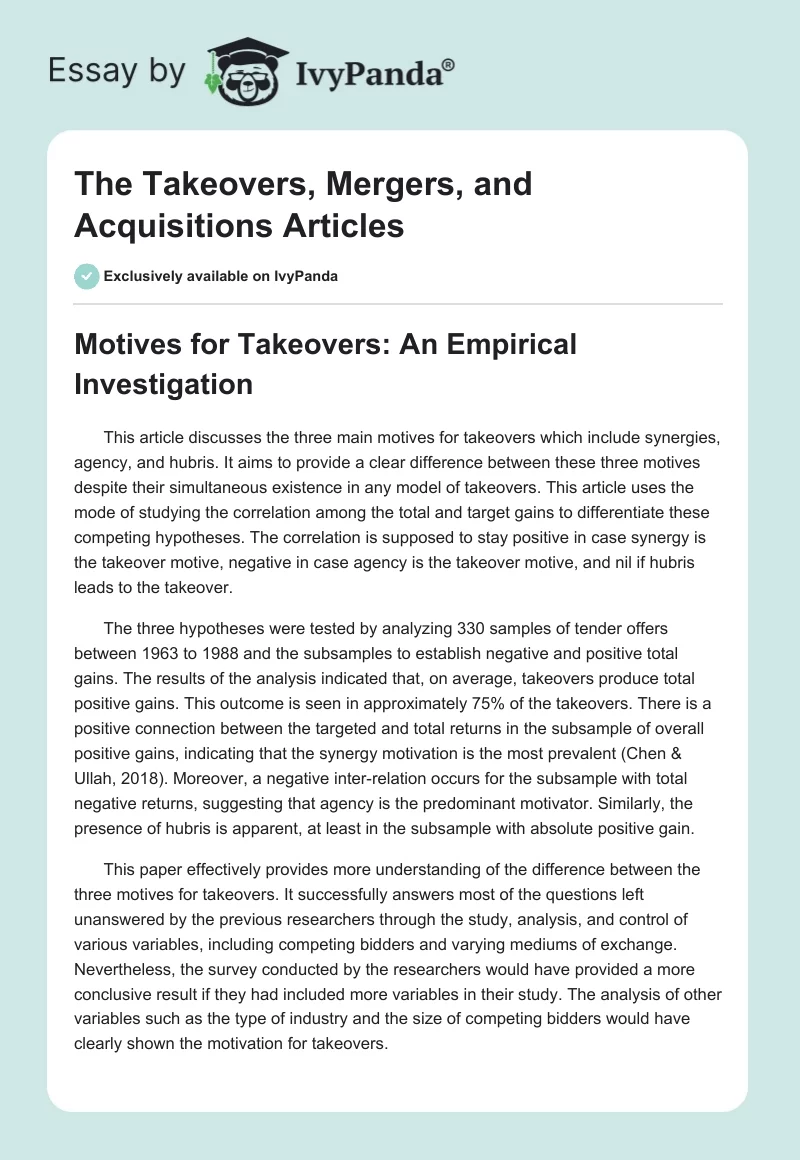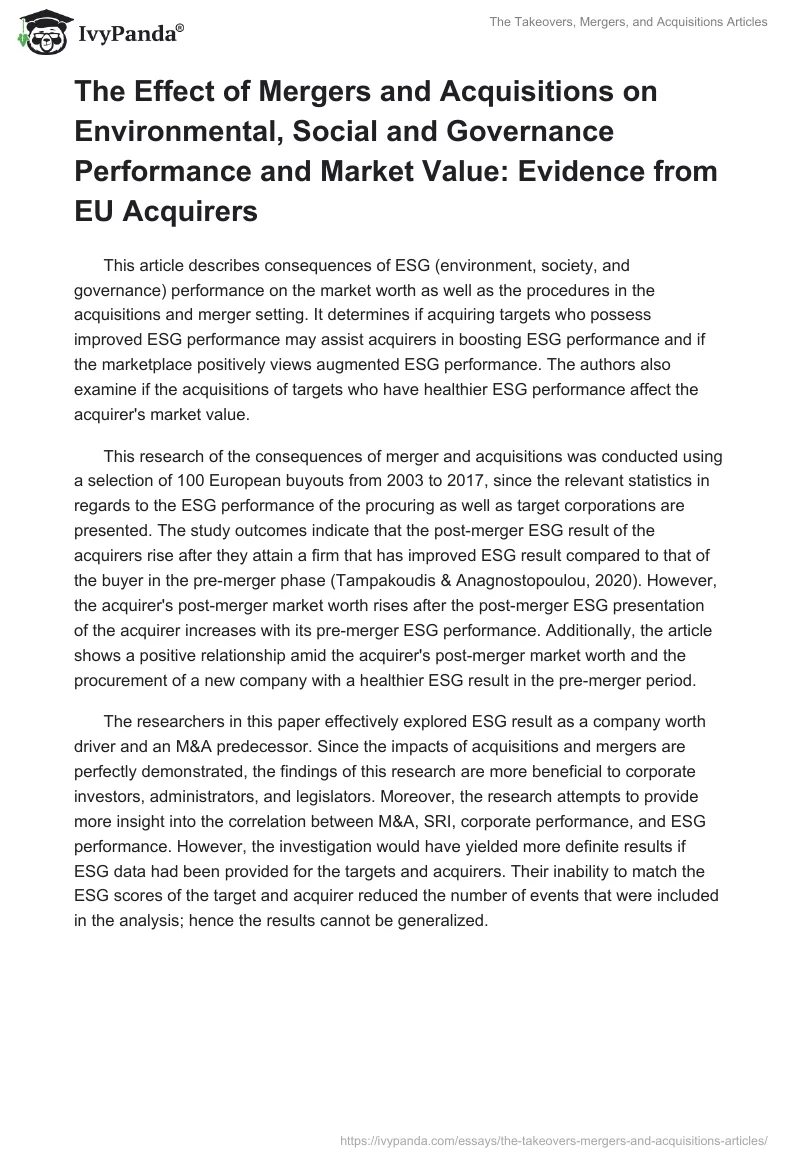Motives for Takeovers: An Empirical Investigation
This article discusses the three main motives for takeovers which include synergies, agency, and hubris. It aims to provide a clear difference between these three motives despite their simultaneous existence in any model of takeovers. This article uses the mode of studying the correlation among the total and target gains to differentiate these competing hypotheses. The correlation is supposed to stay positive in case synergy is the takeover motive, negative in case agency is the takeover motive, and nil if hubris leads to the takeover.
The three hypotheses were tested by analyzing 330 samples of tender offers between 1963 to 1988 and the subsamples to establish negative and positive total gains. The results of the analysis indicated that, on average, takeovers produce total positive gains. This outcome is seen in approximately 75% of the takeovers. There is a positive connection between the targeted and total returns in the subsample of overall positive gains, indicating that the synergy motivation is the most prevalent (Chen & Ullah, 2018). Moreover, a negative inter-relation occurs for the subsample with total negative returns, suggesting that agency is the predominant motivator. Similarly, the presence of hubris is apparent, at least in the subsample with absolute positive gain.
This paper effectively provides more understanding of the difference between the three motives for takeovers. It successfully answers most of the questions left unanswered by the previous researchers through the study, analysis, and control of various variables, including competing bidders and varying mediums of exchange. Nevertheless, the survey conducted by the researchers would have provided a more conclusive result if they had included more variables in their study. The analysis of other variables such as the type of industry and the size of competing bidders would have clearly shown the motivation for takeovers.
The Effect of Mergers and Acquisitions on Environmental, Social and Governance Performance and Market Value: Evidence from EU Acquirers
This article describes consequences of ESG (environment, society, and governance) performance on the market worth as well as the procedures in the acquisitions and merger setting. It determines if acquiring targets who possess improved ESG performance may assist acquirers in boosting ESG performance and if the marketplace positively views augmented ESG performance. The authors also examine if the acquisitions of targets who have healthier ESG performance affect the acquirer’s market value.
This research of the consequences of merger and acquisitions was conducted using a selection of 100 European buyouts from 2003 to 2017, since the relevant statistics in regards to the ESG performance of the procuring as well as target corporations are presented. The study outcomes indicate that the post-merger ESG result of the acquirers rise after they attain a firm that has improved ESG result compared to that of the buyer in the pre-merger phase (Tampakoudis & Anagnostopoulou, 2020). However, the acquirer’s post-merger market worth rises after the post-merger ESG presentation of the acquirer increases with its pre-merger ESG performance. Additionally, the article shows a positive relationship amid the acquirer’s post-merger market worth and the procurement of a new company with a healthier ESG result in the pre-merger period.
The researchers in this paper effectively explored ESG result as a company worth driver and an M&A predecessor. Since the impacts of acquisitions and mergers are perfectly demonstrated, the findings of this research are more beneficial to corporate investors, administrators, and legislators. Moreover, the research attempts to provide more insight into the correlation between M&A, SRI, corporate performance, and ESG performance. However, the investigation would have yielded more definite results if ESG data had been provided for the targets and acquirers. Their inability to match the ESG scores of the target and acquirer reduced the number of events that were included in the analysis; hence the results cannot be generalized.
Explaining the Premiums Paid for Large Acquisitions: Evidence of CEO Hubris
Managers typically overpay for target companies for three reasons: synergies, agencies, as well as hubris. Past studies have only found hubris when there are overall negative outcomes following acquisitions. Still, it does not elucidate the concept of managerial hubris to identify the number of premiums paid for a purchase. This article provides the solution to these shortcomings by analyzing three significant properties: the recent performance of the acquirer firm, contemporary media praise, and the degree of self-importance of the acquirer CEO. The researchers theorized a positive relationship between the three properties and the amount of premium paid for acquisitions.
The research was conducted on all publicly traded firms involved in acquisitions with payments exceeding $100 million in 1989 and 1982. The years are chosen to examine robustness over varied economic environments, 1989 was a boom year, and 1992 was a trough year for mergers and acquisitions (Arena et al., 2017). The study results indicate that the premium paid for investments positively correlates with the recent performance of the acquirer, media phrase, and the relative pay of the CEO. Furthermore, the paid premiums were vastly connected to the collective hubris factor.
This paper provides a great analysis of the association between premiums paid for acquisitions and the characteristics of the CEOs. It clearly shows that the nature of the CEO has a significant effect on the premiums paid for large investments when using hubris. Nevertheless, the researchers ought to have included a control for more variables to increase the sample size and show how they affected the hubris and the premium paid for target firms.
Gains to Bidder Firms Revisited: Domestic and Foreign Acquisitions in Canada
The bulk of trade acquisition studies indicates that bidding companies in the US achieve basically minimal profits. Despite numerous evidences demonstrating that rivalry between many bidder firms energizes procurement fees to the intended stakeholders, it is also well known that considered bidder anomalous yields occasionally have a reduction bias. This predisposition may happen when the buyer is close to the target or when a market takeover is predicted due to the dealer’s track record as a regular acquirer. As a result, assessing the correct performance of US dealers is difficult.
This article analyses a broad sample of foreign and domestic procurements in Canada to address the argument over the accurate increases to bidder firms. The authors conduct multiple kinds of research into the possible cause of the differential performance of the local and foreign bidder companies. The study results confirm that the marketplace is inclined to positively respond to local propositions where the imbursement is made using bidder shares. Also, the outcome indicates that domestic acquisitions are more profitable in cases where the buyer and the target have similar total equity scopes.
This paper investigates various variables to show how the performance of local and foreign bidder organizations differs. The authors also record the frequency of similar acquisitions across the domestic and U.S bidders. They incorporate operational tests of numerous hypotheses that the marketplace allocates exact preceding acquisition prospects listed in the sample. The limitation of the study is its failure to efficiently analyze the causation against the correlation of the presented variables. This incorporation would have improved the credibility of the results hence making it more conclusive.
References
Arena, C., Michelon, G., & Trojanowski, G. (2017). Big egos can be green: A study of CEO hubris and environmental innovation. British Journal of Management, 29(2), 316-336.
Chen, X., & Ullah, S. (2018). Motives and consequences of White Knight takeovers. Journal of Corporate Accounting & Finance, 29(3), 47-69.
Tampakoudis, I., & Anagnostopoulou, E. (2020). The effect of mergers and acquisitions on environmental, social and governance performance and market value: Evidence from EU acquirers.Business Strategy and The Environment, 29(5), 1865-1875.


